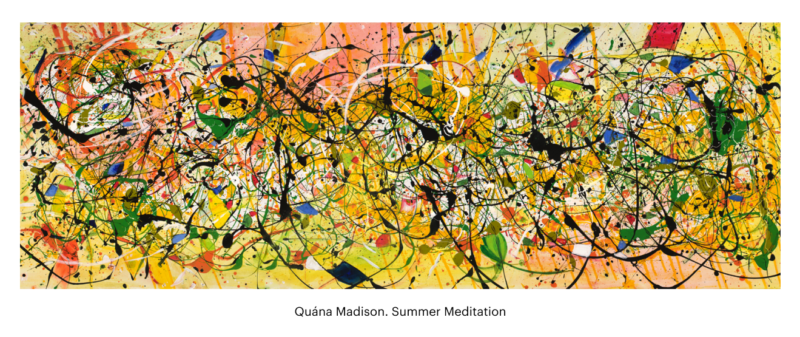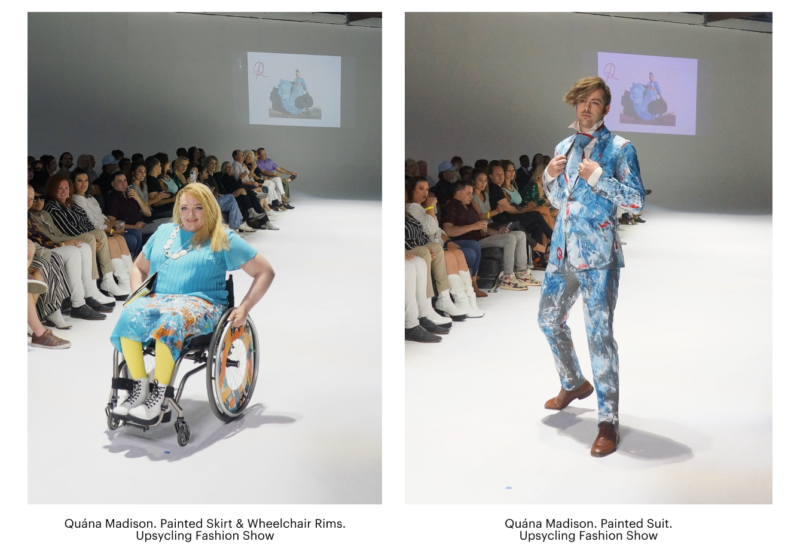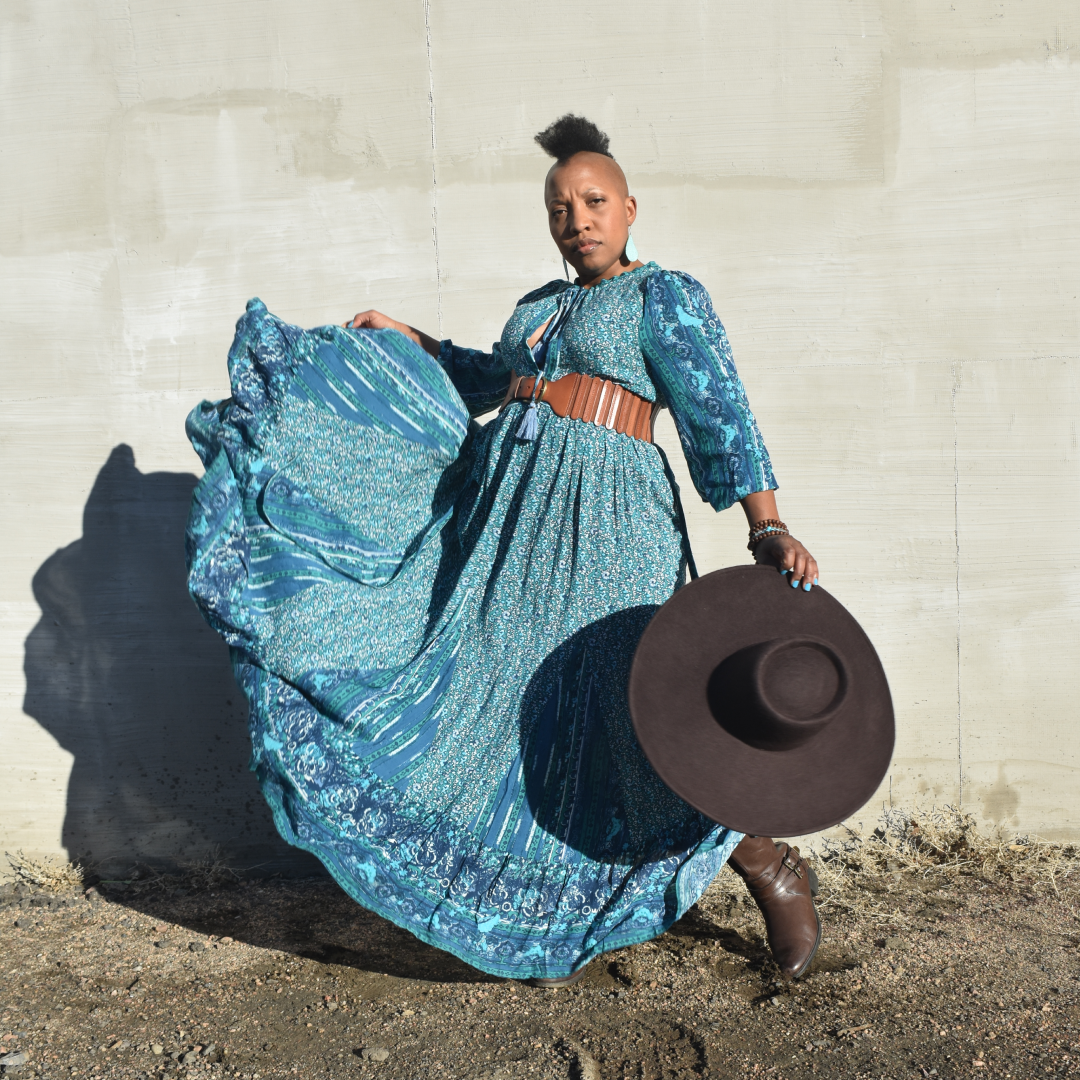Quána Madison is an artist and mindfulness teacher who turned to art after having a near-death experience following cancer surgery. In an interview with Fine Art Shippers, Quána talked about the ordeal she went through and how art can change one's direction in life, as well as heal both mental and physical traumas.
Artist Talk: Quána Madison on Art as Healing Practice
Do you remember that particular moment or day when you felt a desire to create art?
Quána Madison: I was an educator for almost twenty years and never did any visual art as an adult. It was my near-death experience that made me feel a desire to create art. It happened after complications from cancer previvor surgeries, double mastectomies, hysterectomy, and an oophorectomy. Several months later, an internal incision opened, and I began to bleed out. I was alone at my friend's home and lost consciousness. During this time, I had an out-of-body experience, floating above my body.
When the EMTs arrived, they initially thought I was dead. In this state, I encountered what I call light beings, others might say angels, who reassured me that everything would be okay, that it wasn't my time, and that I was not alone. I felt an overwhelming sense of unconditional love and didn't want to return, but they insisted, saying I had soul agreements to fulfill. Suddenly, I felt a push, started coughing, and the EMTs realized I was alive. I underwent life-saving surgery afterward.
This ordeal led me to reevaluate my life's purpose and meaning. During this period, I developed incurable illnesses like fibromyalgia, chronic pain, chronic fatigue, and an autoimmune disease, which drastically changed my life. I faced financial ruin due to medical debts and eventually became homeless. I also struggled with depression, anxiety, complex trauma, PTSD, and suicidal thoughts. In my search for a way forward, I often found myself reflecting on my near-death experience. From this reflection, I received a clear message: to embrace my inner artist. So, inspired by this message, I began experimenting with art supplies.
What happened next? How was your art practice evolving?
My husband, Zachariah White, whom I had recently met, was incredibly supportive; he encouraged me to explore art as a way of healing and expressing my authentic self. I began drawing with oil pastels and writing poetic expressive letters, despite still experiencing tremors and convulsions which made holding anything very difficult. Through art, I found a way to express myself in ways that words alone couldn't capture. It became a means of processing and understanding the experiences I had gone through.
As time passed, I turned to painting. At first, I would stare at paints and brushes, paralyzed by the fear of failure. Eventually, I gathered the courage to begin. I discovered that painting brought me a feeling of deep inner peace. It was a form of creative meditation, filling me with joy, healing, and a sense of purpose. Now, over seven years into that timeline, art has not only provided me with fulfillment but also instilled a belief that engaging in arts may extend my life. And although the future remains uncertain, I am continuing this path because this is my life now.

These days, you not only practice art but also teach art as a healing practice. How did you start doing that?
During my own challenging journey, I had lost my health insurance and couldn't access psychological supports or mental health programs. After getting my life back on track, I began reflecting on how I could help others access the arts as a path to support their well-being, especially mental health. I began seeking opportunities and connected with an organization called Colorado Artists in Recovery through a mutual friend. After sharing my story with their executive director, I received an invitation to consult with the organization and facilitate my signature Creative Meditation workshop. Initially, it was a one-time event, but it went so well that I was asked to teach a six-week class and additional community classes with partner organizations. Over time, this collaboration grew, opening more opportunities for me.
I began working with Catholic Charities, Samaritan House in Denver, to facilitate healing arts workshops with veterans and women experiencing homelessness. Today, I conduct my Creative Meditation workshops for a variety of clients, including correctional facilities for women, corporate businesses, art museums, and nonprofits serving LGBTQ+ community members. This has been an incredibly rewarding experience.
What is your approach to teaching art as a way to achieve well-being?
I found that being a peer in this workshop context helped participants feel comfortable and open up. I act as a bridgewalker, guiding them to explore activities and artistic resources for their well-being.
In my Creative Meditation workshops, we build a sense of community and connection. I use different kinds of meditation practices, such as mantra chanting, affirmations, contemplation or visualization meditation. I introduce art activities focused on cultivating mindfulness, self-compassion, self-worth, self-care, self-awareness, and emotional regulation. I distribute creative prompts and art materials, encouraging participants to explore them in meaningful ways that resonate with them. I hold space for folks to share with each other or the whole group.
I share and host discussions about various forms of art in the workshops, ranging from works by both famous and lesser-known artists to pieces of poetry, music, dance, and drama. I believe all forms of art can benefit and be appreciated by everyone, not just by “professional” artists or art experts.

What does self-compassion mean to you?
Self-compassion is about being a supportive friend to ourselves. We often tend to be overly critical of ourselves, which can harm our mental well-being and relationships. Initially, while struggling with health issues like chronic pain and fatigue, I was tough on myself, believing that I could overcome these problems with more effort, problematic perfectionist behaviors, and unhealthy thought patterns. But over time, I realized that some things can't be changed. I learned to accept my feelings and the changes in my life with kindness and understanding. Embracing self-compassion motivated me to learn more about holistic ways to nourish wellbeing. To me, practicing well-being as a lifelong commitment is the essence of self-compassion.
Interview by Inna Logunova Photo courtesy of Quána Madison
